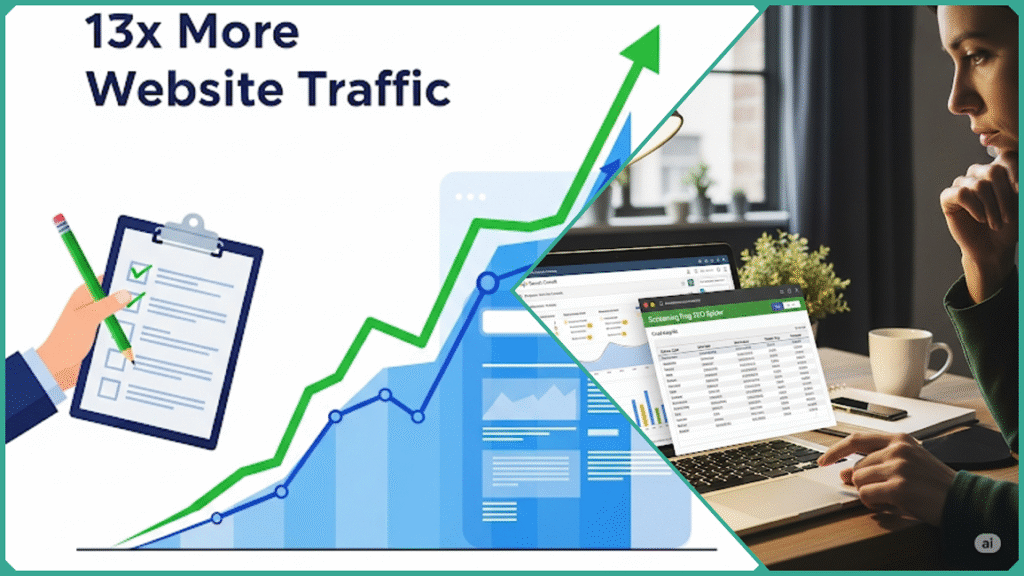Simple On-Page SEO Audits to Get 13x More Website Traffic
Estimated reading time: 25 minutes
Increasing your website’s traffic can often seem like a very overwhelming and challenging task, particularly if you do not have extensive experience or expertise in the complex world of digital marketing. Nevertheless, by adopting the correct strategies and methods, even individuals who possess only basic technical knowledge or limited digital skills can greatly improve the overall performance and visitor numbers of their website.
One highly effective and remarkably easy-to-implement strategy that can significantly enhance your website’s performance is performing On-Page SEO Audits. This powerful and insightful approach has the potential to boost your site traffic by up to an impressive 13 times, making it an absolute game-changer for a wide range of professionals, including digital marketers, small business owners, entrepreneurs, content creators, bloggers, and freelancers alike.

On-page SEO audits involve evaluating and optimizing multiple elements on your website to improve its visibility and ranking in search engine results pages (SERPs). This process is crucial for meeting user intent, keeping search engines happy, and ultimately driving targeted organic traffic that boosts your career, business growth, and content reach.
This detailed blog post will guide you through the essential aspects of what on-page SEO audits entail, why they hold such significant influence in the world of digital marketing, the most recent trends shaping their evolution, and practical, straightforward steps you can start implementing right away to achieve impressive and tangible results for your website’s performance and visibility.
What Is an On-Page SEO Audit?
An On-Page SEO Audit is a comprehensive evaluation of all the on-site factors present on your website that influence its ranking in search engines, as well as the overall user experience. This type of audit carefully examines various components such as content quality, keyword usage, meta tags, site structure, and internal linking.
Unlike off-page SEO, which primarily focuses on external elements like backlinks and outside signals that drive authority and traffic, on-page SEO audits specifically concentrate on optimizing the elements that exist within your own website itself to improve visibility and engagement.
Key elements evaluated during an on-page SEO audit include:
Key components thoroughly reviewed and analyzed in an on-page SEO audit include a variety of essential elements such as meta tags, header tags, keyword usage, URL structure, internal linking, page load speed, mobile-friendliness, content quality, image optimization, and overall user experience.
These factors collectively contribute to optimizing a webpage’s visibility and relevance in search engine results, ensuring that each aspect supports better ranking and improved traffic.
- Content Quality and Relevance: Ensuring that your content is not only valuable and informative but also thoroughly addresses users’ queries clearly and engagingly, while seamlessly and naturally incorporating relevant keywords. This process also involves carefully identifying and resolving issues related to thin, duplicate, or outdated content to maintain the overall quality and effectiveness of your website’s material.
- Keywords and Their Placement: Conducting a thorough audit to identify and assign unique primary keywords for each page, which helps to effectively avoid issues related to keyword cannibalization. Additionally, it is essential to ensure that these keywords are strategically and appropriately placed throughout the page, including in critical areas such as titles, headings, and the main body content, to maximize SEO effectiveness and improve overall search engine rankings.
- Meta Tags (Titles and Descriptions): Ensuring that every single page on the website possesses a unique, well-crafted, and concise title tag that effectively incorporates relevant keywords—typically kept under 60 characters in length—and a compelling, engaging meta description that is under 160 characters. This description should be designed to attract and encourage users to click through from search engine results pages.
- URL Structure: URLs should be clean, straightforward, and descriptive, incorporating relevant keywords that accurately reflect the content of the page. Avoid unnecessary complexity or excessive parameters to ensure the URLs are easy to read and understand. This approach not only helps search engines to better index and rank the pages but also improves the user experience by clearly indicating the topic or purpose of the page at a glance. A well-structured URL is an essential component of effective SEO and site navigation.
- Headings (H1, H2, etc.): Proper and correct use of header tags is essential to logically organize the content on a webpage, which significantly enhances readability for users. Additionally, it allows search engines to better comprehend the overall structure and hierarchy of the page, improving SEO effectiveness and user experience.
- Image Optimization (Alt Text): Adding detailed and descriptive alt attributes to images that include relevant and targeted keywords, which not only enhances accessibility for users with disabilities but also significantly helps search engines better understand and categorize the visual content, ultimately improving overall SEO performance.
- Internal Linking: The strategic practice of creating links between different pages within your own website to effectively distribute page authority across various sections. This not only enhances user navigation by guiding visitors smoothly through related content but also significantly aids search engines in crawling and indexing your site more efficiently, ultimately improving your website’s overall SEO performance.
- Site Architecture and User Experience: Conducting a thorough review of the website’s navigation system and overall structural design to ensure it is highly intuitive and user-friendly. This process helps users locate the information they need quickly and efficiently, while also improving the site’s crawlability and indexing by search engines. By optimizing both navigation and structure, the website delivers a seamless experience that benefits both visitors and search engine algorithms alike.
- Page Load Speed and Mobile-Friendliness: Thoroughly testing and continuously improving how quickly your web pages load, along with ensuring a smooth and seamless user experience on all types of mobile devices, are both crucial elements. These factors play a significant role as key ranking criteria established by major search engines, directly impacting your website’s visibility and overall performance in search results.
The ultimate goal of conducting a thorough on-page SEO audit is to carefully identify and effectively address any existing issues or obstacles that may be limiting your website’s overall search engine performance as well as user engagement.
This process involves offering clear, detailed, and highly actionable recommendations that are specifically tailored to enhance your website’s search engine rankings. By implementing these targeted strategies, you can expect a significant and sustained increase in organic traffic over time, helping to boost your site’s visibility and overall online performance.
Why Are On-Page SEO Audits Important?
The truth is, even the most beautifully designed and thoughtfully written websites can easily get lost in the overwhelming noise of the internet. This usually happens because of hidden on-page issues that negatively impact both search engine rankings and the overall user experience.
By conducting a thorough and simple on-page SEO audit, you gain the most effective method to identify and diagnose these underlying problems. This process helps unlock your website’s full potential, ensuring that every single page is optimized and working diligently to attract more traffic and convert visitors into loyal customers.
On-page SEO audits are essential for your website’s overall success and performance for a variety of compelling and important reasons:
- Boost Organic Traffic: By thoroughly improving your website’s ranking in the Search Engine Results Pages (SERPs), on-page SEO audits significantly increase your visibility to users who are actively searching for content, products, or services that are directly relevant to your specific business. This kind of highly targeted traffic is much more likely to convert into loyal customers or deeply engaged readers, ultimately benefiting your business growth and online presence.
- Enhance User Experience: Conducting a thorough audit plays a crucial role in pinpointing navigation difficulties, slow-loading pages, and various other technical problems that can easily frustrate visitors, causing them to leave the site quickly and resulting in high bounce rates. By addressing and improving these specific aspects, you ensure that visitors remain on your site for longer periods and engage with your content more deeply and meaningfully. This enhanced user experience not only benefits your audience but also has a positive impact on your search engine rankings, helping your website perform better overall.
- Increase Conversion Rates: Optimized web pages that feature highly relevant and targeted content, combined with clear, compelling calls-to-action, have a much greater ability to guide visitors smoothly and effectively towards the desired outcomes, such as making purchases, completing sign-ups, or submitting inquiries. This strategic approach not only enhances user experience but also significantly boosts overall conversion rates, leading to increased engagement and better business results.
- Stay Competitive: SEO audits play a crucial role in keeping you well-informed about the constantly evolving search engine algorithms as well as the latest strategies employed by your competitors. By regularly conducting these audits, you gain valuable insights that empower you to effectively adapt and optimize your website. This proactive approach ensures that you can maintain your current search engine rankings or even improve them, helping you stay ahead in an increasingly competitive and ever-changing digital landscape.
- Fix Technical and Content Errors: Audits reveal a variety of issues that can negatively impact your site’s SEO performance, including broken links that disrupt user experience, duplicated or thin content that diminishes your site’s authority, and missing or poorly optimized meta descriptions that fail to attract clicks from search engine results. Identifying and resolving these problems is crucial for improving your website’s overall visibility and search engine ranking.
Studies consistently show that websites that regularly perform thorough on-page SEO audits and diligently act on the insights and findings derived from these audits can experience truly remarkable and substantial results, including traffic growth that can be as much as 13 times greater than the original volume.
This impressive growth is largely driven by addressing the detailed recommendations and insights uncovered during the audit process, which help ensure that your site not only meets but exceeds both user expectations and the rigorous criteria set by search engines effectively and sustainably.
Key Components of an On-Page SEO Audit
To build a website that is not only loved by search engines but also highly valued by users, it is essential to concentrate on several key foundational elements. Conducting an on-page SEO audit involves thoroughly examining these critical building blocks—from the specific words and phrases you choose to the overall way your website is structured and organized.
We will break down the most crucial components that you need to carefully review and optimize to ensure that every single page on your site is fully prepared and optimized for maximum success in search rankings and user experience.
Here are the Key Components of an On-Page SEO Audit thoroughly outlined based on the most recent and up-to-date SEO best practices for 2025, ensuring your website remains highly optimized and competitive in search engine rankings:
- Crawl Your Website: Use powerful SEO tools such as Screaming Frog, SEMrush, or Ahrefs to perform a thorough crawl of your entire website. These advanced tools help you identify a wide range of issues, including broken links, duplicate or thin content, missing or incomplete metadata, and structural problems that can negatively impact your site’s performance. Conducting this detailed scan offers a comprehensive overview of your website’s overall health and serves as the essential foundation for building an effective and insightful audit.
- Analyze Page Titles and Meta Descriptions: Page titles and meta descriptions are your website’s first impression in search results. They are the tiny, clickable advertisements that entice users to choose your page over a competitor’s. Ensuring they are optimized is a simple yet powerful step to boost your click-through rate and drive more traffic.
- Page Titles: Ensure each page has a unique title, is under 60 characters, and contains your primary keyword near the beginning.
- Meta Descriptions: Must be concise (below 160 characters), compelling, and include relevant keywords to improve click-through rates.
- Evaluate Content Quality and Keyword Usage: Content must be highly relevant, informative, and engaging to effectively capture and maintain the audience’s attention. It should be thoughtfully structured using clear headings, bullet points, and appropriate visuals to enhance readability and user experience. Incorporate both primary keywords and related secondary keywords seamlessly and naturally throughout the text, ensuring that keyword usage enhances the content without leading to keyword stuffing or compromising the quality of the writing.
- Assess URL Structure: URLs should be clean, clear, and descriptive, containing relevant keywords that accurately reflect the content of the page. At the same time, they should avoid unnecessary parameters, excessive numbers, or overly complex structures that can confuse both users and search engines. Maintaining a simple URL structure significantly enhances crawlability by search engines and improves the overall user experience by making links easier to read, remember, and share.
- Optimize Headings and Images Effectively: Make sure to use heading tags correctly and consistently, such as H1, H2, H3, and so on, to clearly organize and structure your content for better readability and navigation. Additionally, all images should include descriptive alt text that contains relevant keywords; this not only improves accessibility for users with disabilities but also enhances your SEO performance by helping search engines understand the image content.
- Review Internal Linking: Internal links play a crucial role in distributing page authority throughout your website and effectively guiding users to related and relevant content. This not only enhances user engagement by encouraging visitors to explore more pages but also significantly supports your SEO efforts. By creating a well-structured internal linking system, you make it easier for search engines to crawl and index your site, improving overall visibility and ranking potential.
- Test Site Speed and Mobile-Friendliness: Page speed and mobile optimization are essential and critical ranking factors that can significantly impact your website’s performance in search engine results. Use reliable and powerful tools like Google PageSpeed Insights and GTmetrix to thoroughly analyze your site and identify any issues that may be causing slow load times, such as large image files, excessive or inefficient JavaScript, and other elements that can hinder your site’s speed. Additionally, make sure your website is fully optimized to provide a smooth, seamless, and user-friendly experience across all mobile devices, ensuring that visitors can easily navigate and interact with your content regardless of the screen size they are using.
Additional important elements that are sometimes included in a comprehensive on-page SEO audit checklist consist of optimizing schema markup to enhance search engine understanding, addressing and fixing duplicate content issues that could harm rankings, improving accessibility features to ensure the website is usable by all visitors, and carefully reviewing outbound links to maintain quality and relevance.
By carefully and systematically addressing each of these essential components, you can ensure that your website not only meets but exceeds user expectations and aligns perfectly with the evolving search engine requirements anticipated in 2025. This thorough approach effectively sets the foundation for achieving higher search engine rankings and significantly increasing your organic traffic over time.
Current Trends and Developments in On-Page SEO Audits
Current trends and developments in on-page SEO audits for the year 2025 emphasize the growing complexity and advanced sophistication of SEO strategies. These changes are largely driven by the continuous evolution of search engine algorithms, which are becoming more intelligent and nuanced.
Additionally, shifts in user behavior, including how people search and interact with content online, play a significant role in shaping these strategies. As a result, SEO professionals must adapt to these dynamic factors to ensure effective optimization and maintain competitive search rankings.
- User Experience Signals: Search engines place a strong emphasis on various user experience (UX) metrics, with a particular focus on Core Web Vitals. These Core Web Vitals are essential measurements that assess key aspects of a website’s performance, including loading speed, interactivity, and visual stability. Ensuring that these metrics are optimized is incredibly important not only for achieving higher rankings in search engine results but also for meeting and exceeding user expectations, ultimately leading to a better overall browsing experience.
- AI-Powered Content Analysis: Advanced SEO tools today increasingly leverage artificial intelligence to conduct a much deeper and more sophisticated assessment of content. These tools focus not only on basic keyword presence but also evaluate how effectively the content aligns with the specific intent of users, the level of engagement it generates, and its overall comprehensiveness in covering the topic. This represents a significant evolution in SEO strategies, moving beyond traditional simple keyword matching toward a more nuanced understanding of the context, relevance, and quality of the content presented to audiences.
- Mobile-First Indexing: With Google now primarily focusing on indexing the mobile versions of websites, optimizing for mobile has become essential and is no longer an optional aspect of web design. To achieve high rankings in search results, websites must prioritize implementing a responsive design that adapts seamlessly to various screen sizes and devices. Additionally, it is crucial to ensure fast loading speeds, specifically on mobile devices, as slow performance can negatively impact user experience and search rankings. Equally important is providing accessible and intuitive navigation on mobile platforms, allowing users to easily find and interact with content without frustration.
- Structured Data & Schema Markup: Using schema markup is an essential strategy that helps search engines gain a deeper understanding of the content and its broader context. By implementing structured data, websites can enhance the way their pages are displayed in search engine results, often leading to improved search snippet appearances such as rich results, featured snippets, and other visually enhanced listings. These enriched search snippets not only make the content more attractive and informative at a glance but also significantly increase the likelihood that users will click through to the site, ultimately boosting overall click-through rates and driving more organic traffic.
- Voice Search Optimization: The rapid rise and growing popularity of voice search technology have significantly shifted the focus of optimization strategies toward natural language processing. This means using conversational keywords and question-based queries that people naturally speak rather than type. Effectively optimizing for voice search involves specifically targeting featured snippets on search engines and adopting a more natural, conversational writing style that mirrors how users verbally ask questions and seek information.
Leading SEO tools have increasingly integrated these emerging trends into their on-page audit capabilities, providing users with advanced AI-generated insights, thorough Core Web Vitals reporting, detailed mobile usability analysis, and comprehensive structured data checks. These features work together to deliver a holistic approach to site optimization, ensuring websites perform better across various metrics and improve overall search engine rankings.
By actively embracing and integrating these emerging trends, businesses can significantly enhance the effectiveness of their SEO audits, ensuring that their websites not only meet current standards but also remain highly competitive and visible in the rapidly evolving and dynamic search landscape of 2025 and the years beyond. This proactive approach helps companies stay ahead of algorithm updates and user behavior changes, ultimately driving sustained online success.
Simple Step-by-Step On-Page SEO Audit You Can Do Today
Now that you have a clear understanding of what an on-page SEO audit entails and why it holds such critical importance for your website’s success, it’s time to take that valuable knowledge and put it directly into action.
Instead of getting overwhelmed by complex, expensive software tools that can be confusing and costly, this straightforward, step-by-step guide will walk you through the precise process you can use to thoroughly audit your own website starting right now. By following these simple instructions, you’ll be able to identify key areas of improvement and begin seeing a noticeable boost in your website traffic in no time.
Here is a Simple Step-by-Step On-Page SEO Audit You Can Easily Do Today using accessible, user-friendly tools and practical, actionable steps designed to significantly boost your website’s SEO performance and improve your search engine rankings:
- Prepare Your Tools Start by gathering essential free or freemium SEO tools such as Screaming Frog, Google Search Console, Google PageSpeed Insights, and Ahrefs (using either their trial period or free version). These powerful tools will enable you to thoroughly scan, monitor, and analyze your website’s performance and SEO health, providing valuable insights to optimize your site effectively.
- Run a Website Crawl: Use powerful tools such as Screaming Frog or Ahrefs to perform a comprehensive crawl of your entire website. During this process, carefully identify critical issues, including broken URLs, missing or duplicate meta titles, and pages with thin or insufficient content. Conducting this detailed scan provides a solid foundation and essential data that will serve as the basis for your thorough website audit.
- Review Titles and Meta Descriptions: Carefully examine page titles to ensure they are unique across your site, include important keywords near the beginning, and maintain an optimal length of under 60 characters for best SEO performance. Additionally, thoroughly review meta descriptions to confirm they are engaging, rich in relevant keywords, and concise, ideally staying within 160 characters. Make necessary edits to any titles or meta descriptions that are missing, incomplete, or poorly crafted to improve search engine visibility and click-through rates.
- Check Content Quality Thoroughly: Carefully scan your web pages to identify thin, weak, or irrelevant content that may not provide real value to your audience. Enhance these sections by adding detailed, valuable information that addresses your readers’ needs. Improve the overall readability by restructuring the content using clear headings, subheadings, and bullet points to break up large blocks of text. Using tools like Grammarly or Hemingway Editor can significantly help you polish the text, ensuring it is grammatically correct and easy to understand, ultimately making your content more engaging and professional.
- Improve URL Structures: Make sure that your URLs are concise, clear, and easy to understand by both users and search engines. They should include relevant keywords that accurately describe the content of the page. For example, a clean and straightforward URL such as yoursitename.com/seo-audit is much more effective and user-friendly than a complicated URL like yoursitename.com/pageid=123, which offers no indication of the page’s content. This approach not only improves user experience but also helps improve your search engine rankings by making it easier for crawlers to index your site.
- Optimize Images: Ensure that you add detailed and descriptive alt text containing relevant keywords to every image on your website. This not only enhances SEO but also improves accessibility for users relying on screen readers. Additionally, compress all images efficiently to significantly speed up page loading times while still preserving the visual quality and clarity of the images.
- Test Site Speed: Use the powerful tool Google PageSpeed Insights to thoroughly analyze your website’s loading times and performance. This tool provides detailed and specific recommendations for improving your site, including optimizing images for faster loading, implementing effective caching strategies, and reducing or eliminating unnecessary scripts that may slow down your pages. By following these suggestions, you can significantly enhance your website’s speed and overall user experience.
- Mobile Usability Check: Verify how your website performs on a wide range of mobile devices by using Google’s comprehensive Mobile-Friendly Test tool. This test helps identify any problems related to responsive design, inappropriate font sizes, or touch elements that are difficult to interact with. Addressing these issues will ensure a smoother, more user-friendly experience for visitors accessing your site on smartphones and tablets.
- Check Internal Links: Make sure your website’s pages contain internal links that use keyword-rich anchor texts directing visitors to your most important and relevant pages. Effective internal linking not only helps distribute page authority evenly across your site but also enhances user experience by guiding visitors intuitively through your content, making navigation smoother and more logical.
- Track and Implement Changes: After making important improvements to your website, it is essential to continuously monitor your site’s overall performance using powerful tools like Google Analytics and Google Search Console. These tools allow you to carefully analyze various metrics such as traffic fluctuations, click-through rates, user engagement, and search engine rankings, providing valuable insights into how well your changes are working over time.
This straightforward and clear approach makes it simple and accessible for anyone to effectively audit and improve on-page SEO using popular tools and a series of step-by-step actions. By consistently applying this well-structured process, you will be able to significantly increase your website’s visibility, enhance the overall user experience, and ultimately drive more organic traffic to your site over time.
Case Study Example: Small Business Boosting Traffic 13x with On-Page SEO Audit
A compelling and detailed case study that clearly illustrates the incredible power of conducting a thorough on-page SEO audit for small businesses is that of a small e-commerce clothing store. This particular business was able to dramatically increase its organic website traffic by an impressive 13 times within just six months by implementing the insights and recommendations gained from a focused and comprehensive on-page SEO audit.
The store initially started by making use of various free SEO tools to carefully identify and address several critical issues that were affecting its online presence and performance:
- Broken Links: They thoroughly identified and meticulously repaired all broken URLs throughout the website, which significantly enhanced overall site navigation and greatly improved the user experience for visitors.
- Page Titles and Meta Descriptions: They thoroughly rewrote and optimized page titles and meta descriptions by thoughtfully incorporating primary keywords, significantly enhancing the relevance and appeal of their pages in search engine results. This strategic approach helped improve visibility and attract more targeted traffic to their website.
- Content Quality: The store significantly enhanced its content to be far more relevant, comprehensive, and engaging for its specific target audience, making sure it thoroughly addressed user intent clearly and effectively. This improvement helped to better connect with visitors and provide valuable information tailored to their needs.
- Page Speed Optimization: By effectively compressing images and carefully streamlining various elements on their web pages, they were able to significantly enhance loading speeds. This improvement plays a crucial role not only in search engine ranking but also in providing a much better user experience for visitors to the site.
As a direct result of implementing these strategic changes, the store experienced an impressive thirteenfold increase in organic traffic. This substantial growth in visitors led directly to a significant boost in sales, demonstrating the effectiveness of the approach. Remarkably, all of this success was achieved without any extra expenditure on paid advertising campaigns or promotional budgets.
This case serves as a clear example of how even small businesses, which often operate with limited budgets and constrained resources, can still achieve substantial and impressive growth by carefully and methodically applying the valuable insights gained from a detailed on-page SEO audit.
FAQs
How often should I perform an on-page SEO audit?
Perform comprehensive SEO audits every quarter to ensure your website remains fully optimized and well-aligned with the constantly evolving search engine algorithms. Many industry experts suggest conducting monthly SEO audits, especially for highly active websites or immediately following significant website updates or changes.
At the very least, it is advisable to carry out a detailed audit every six months to maintain strong performance, while also performing more frequent mini-audits or quick checks to promptly identify and address any sudden or unexpected issues that may arise.
Can I do an SEO audit myself without technical skills?
Many popular SEO tools, such as Screaming Frog, Google Search Console, and Google PageSpeed Insights, are designed to be quite user-friendly and accessible. This comprehensive guide provides a clear and simple step-by-step process that is especially suitable for beginners who may not have any advanced or deep technical experience. It aims to make SEO tasks easier to understand and implement effectively.
How long does an on-page SEO audit take?
A basic audit can typically be completed within a few hours when dealing with smaller websites that have limited pages and content. On the other hand, comprehensive audits for larger or more complex sites may take several days to finish, depending on the overall size of the site and the level of detail required in the audit process.
What tools are best for on-page SEO audits?
Popular tools used by professionals include Screaming Frog, Google Search Console, Ahrefs, SEMrush, Google PageSpeed Insights, and GTmetrix. Many of these tools provide free versions or trial periods that are perfectly suitable for conducting thorough audits and gaining valuable insights.
Will fixing on-page SEO guarantee increased traffic?
Fixing on-page SEO significantly improves your chances of higher rankings and traffic, but results depend on other factors like competition, quality of content, and off-page SEO (like backlinks). SEO is a holistic practice, so continuous optimization is key.
In Conclusion
Performing a simple on-page SEO audit is a powerful yet manageable strategy to dramatically increase your website traffic—potentially by thirteen times or more. By systematically optimizing your site’s content, meta elements, URLs, images, and user experience, you attract highly targeted organic visitors who can boost your business, career, or content reach.
This guide has demystified the process of on-page SEO auditing, making it accessible to aspiring digital marketers, entrepreneurs, and content creators. Starting today, you can leverage the tools and step-by-step methods outlined here to transform your website into a traffic-generating powerhouse.
For those ready to dive deeper, exploring advanced SEO courses or professional SEO audit services can help maintain and scale your SEO success in 2025 and beyond. Real-world case studies across industries—from e-commerce to education and local services—show that focused on-page SEO efforts not only elevate rankings and traffic but also deliver significant business growth and revenue gains.
The key takeaway is unmistakably clear and important: maintaining a consistent, strategic approach to on-page SEO auditing is not just beneficial but essential. It is a continuous, ongoing practice that every website must prioritize to achieve and sustain long-term visibility and success.
In today’s highly competitive and ever-evolving digital landscape, neglecting this critical aspect can significantly hinder a website’s ability to perform well and attract the right audience over time.
Discover more from Skill to Grow
Subscribe to get the latest posts sent to your email.






